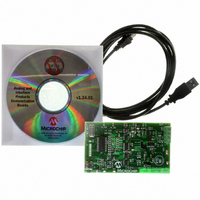TMPSNS-RTD1 Microchip Technology, TMPSNS-RTD1 Datasheet - Page 265

TMPSNS-RTD1
Manufacturer Part Number
TMPSNS-RTD1
Description
BOARD EVAL PT100 RTD TEMP SENSOR
Manufacturer
Microchip Technology
Datasheets
1.MCP3301-CIMS.pdf
(32 pages)
2.PCM18XR1.pdf
(438 pages)
3.MCP6S22DM-PICTL.pdf
(43 pages)
4.TMPSNS-RTD1.pdf
(26 pages)
Specifications of TMPSNS-RTD1
Sensor Type
Temperature
Interface
USB
Embedded
Yes, MCU, 8-Bit
Utilized Ic / Part
MCP3301, MCP6S26, PIC18F2550
Processor To Be Evaluated
MCP6S26, MCP3301, MCP6024, MCP41010, PIC18F2550, TC1071, MCP6002
Data Bus Width
12 bit
Interface Type
USB
Lead Free Status / RoHS Status
Not applicable / Not applicable
Voltage - Supply
-
Sensitivity
-
Sensing Range
-
Lead Free Status / RoHS Status
Lead free / RoHS Compliant, Not applicable / Not applicable
- MCP3301-CIMS PDF datasheet
- PCM18XR1 PDF datasheet #2
- MCP6S22DM-PICTL PDF datasheet #3
- TMPSNS-RTD1 PDF datasheet #4
- Current page: 265 of 438
- Download datasheet (7Mb)
20.4
Synchronous Slave mode is entered by clearing bit,
CSRC (TXSTA<7>). This mode differs from the
Synchronous Master mode in that the shift clock is sup-
plied externally at the CK pin (instead of being supplied
internally in Master mode). This allows the device to
transfer or receive data while in any power-managed
mode.
20.4.1
The operation of the Synchronous Master and Slave
modes is identical, except in the case of the Sleep
mode.
If two words are written to the TXREG and then the
SLEEP instruction is executed, the following will occur:
a)
b)
c)
d)
e)
TABLE 20-9:
© 2009 Microchip Technology Inc.
INTCON
PIR1
PIE1
IPR1
RCSTA
TXREG
TXSTA
BAUDCON
SPBRGH
SPBRG
Legend: — = unimplemented, read as ‘0’. Shaded cells are not used for synchronous slave transmission.
Note 1:
Name
The first word will immediately transfer to the
TSR register and transmit.
The second word will remain in the TXREG
register.
Flag bit, TXIF, will not be set.
When the first word has been shifted out of TSR,
the TXREG register will transfer the second word
to the TSR and flag bit, TXIF, will now be set.
If enable bit, TXIE, is set, the interrupt will wake
the chip from Sleep. If the global interrupt is
enabled, the program will branch to the interrupt
vector.
EUSART Synchronous
Slave Mode
Reserved in 28-pin devices; always maintain these bits clear.
EUSART SYNCHRONOUS
SLAVE TRANSMISSION
EUSART Transmit Register
EUSART Baud Rate Generator Register High Byte
EUSART Baud Rate Generator Register Low Byte
GIE/GIEH PEIE/GIEL TMR0IE
ABDOVF
SPPIF
SPPIE
SPPIP
CSRC
SPEN
Bit 7
REGISTERS ASSOCIATED WITH SYNCHRONOUS SLAVE TRANSMISSION
(1)
(1)
(1)
RCIDL
ADIE
ADIP
ADIF
Bit 6
RX9
TX9
RXDTP
SREN
TXEN
RCIE
RCIP
RCIF
Bit 5
PIC18F2455/2550/4455/4550
TXCKP
INT0IE
CREN
SYNC
TXIF
TXIE
TXIP
Bit 4
ADDEN
SENDB
BRG16
SSPIF
SSPIE
SSPIP
To set up a Synchronous Slave Transmission:
1.
2.
3.
4.
5.
6.
7.
8.
9.
RBIE
Bit 3
Enable the synchronous slave serial port by
setting bits, SYNC and SPEN, and clearing bit,
CSRC.
Clear bits, CREN and SREN.
If interrupts are desired, set enable bit, TXIE.
If the signal from the CK pin is to be inverted, set
the TXCKP bit. If the signal from the DT pin is to
be inverted, set the RXDTP bit.
If 9-bit transmission is desired, set bit, TX9.
Enable the transmission by setting enable bit,
TXEN.
If 9-bit transmission is selected, the ninth bit
should be loaded in bit, TX9D.
Start transmission by loading data to the TXREG
register.
If using interrupts, ensure that the GIE and PEIE
bits in the INTCON register (INTCON<7:6>) are
set.
TMR0IF
CCP1IF
CCP1IE
CCP1IP
BRGH
FERR
Bit 2
—
TMR2IE
TMR2IP
TMR2IF
INT0IF
OERR
TRMT
WUE
Bit 1
TMR1IF
TMR1IE
TMR1IP
ABDEN
RX9D
TX9D
RBIF
Bit 0
DS39632E-page 263
on page
Values
Reset
53
56
56
56
55
55
55
55
55
55
Related parts for TMPSNS-RTD1
Image
Part Number
Description
Manufacturer
Datasheet
Request
R

Part Number:
Description:
Manufacturer:
Microchip Technology Inc.
Datasheet:

Part Number:
Description:
Manufacturer:
Microchip Technology Inc.
Datasheet:

Part Number:
Description:
Manufacturer:
Microchip Technology Inc.
Datasheet:

Part Number:
Description:
Manufacturer:
Microchip Technology Inc.
Datasheet:

Part Number:
Description:
Manufacturer:
Microchip Technology Inc.
Datasheet:

Part Number:
Description:
Manufacturer:
Microchip Technology Inc.
Datasheet:

Part Number:
Description:
Manufacturer:
Microchip Technology Inc.
Datasheet:

Part Number:
Description:
Manufacturer:
Microchip Technology Inc.
Datasheet:










